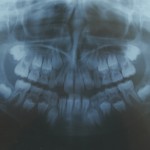
The upper permanent canine normally erupts between 11-12 years of age. However, for between 1-3% of children this does not occur and in 50% of the cases it is due to the tooth being displaced palatally. Two surgical approaches are used to allow orthodontic alignment. An open procedure where a palatal flap is raised ,overlying bone and mucosa removed and a pack placed. In the closed technique bone is removed an orthodontic attachment bonded to the tooth allowing alignment of the tooth from below the mucosa. In a Cochrane review in 2008 (Parkin et al) found no evidence to support the use of 1 technique over the other. The aim of this study was to determine if there were any differences in the outcomes between the open and closed surgical techniques for exposing a palatally displaced maxillary canine (PDC).
What did they do
Patients age 20 years or younger with unilateral palatally ectopic maxillary canines requiring surgical exposure and orthodontic alignment and minimal orthodontic problems other than the ectopic canine were included. They were randomised to receive either open or the closed surgical procedure carried out under general anaesthesia by specialist oral surgeons or oral and maxillofacial surgeons. The outcomes were time spent in the operating room and 10-day postoperative patient questionnaire findings.
What did they find
- 81 patients were recruited.
- One participant randomized to a closed exposure was inadvertently given an open exposure.
- Four participants randomized to open exposures were given closed exposures.
- There was a deliberate deviation from the protocol for 2 of these 4 subjects. The surgeon considered that the canine was too high for an open exposure and that there was a significant risk of palatal mucosal overgrowth. These 5 patients were analyzed in their original allocated groups.
- The mean operating times for the open and closed techniques were 34.3 minutes (SD, 11.2 min) and 34.3 minutes (SD, 11.9 min), respectively (P = .986).
- There were no statistically significant differences between the 2 treatment groups for any patient-assessed outcome (P = .05)
The authors concluded
There were no differences in the surgical outcomes investigated in this study between open and closed exposure for palatally displaced maxillary canines.
Links
Parkin NA, Deery C, Smith AM, Tinsley D, Sandler J, Benson PE. No Difference in Surgical Outcomes Between Open and Closed Exposure of Palatally Displaced Maxillary Canines. J Oral Maxillofac Surg. 2012 Jun 5. [Epub ahead of print]PubMed PMID: 22677328.
Parkin N, Benson PE, Thind B, Shah A. Open versus closed surgical exposure of canine teeth that are displaced in the roof of the mouth. Cochrane Database of Systematic Reviews 2008, Issue 4. Art. No.: CD006966. DOI:10.1002/14651858.CD006966.pub2.

[…] No differences in the surgical outcomes between open and closed exposure for palatally displaced max… […]